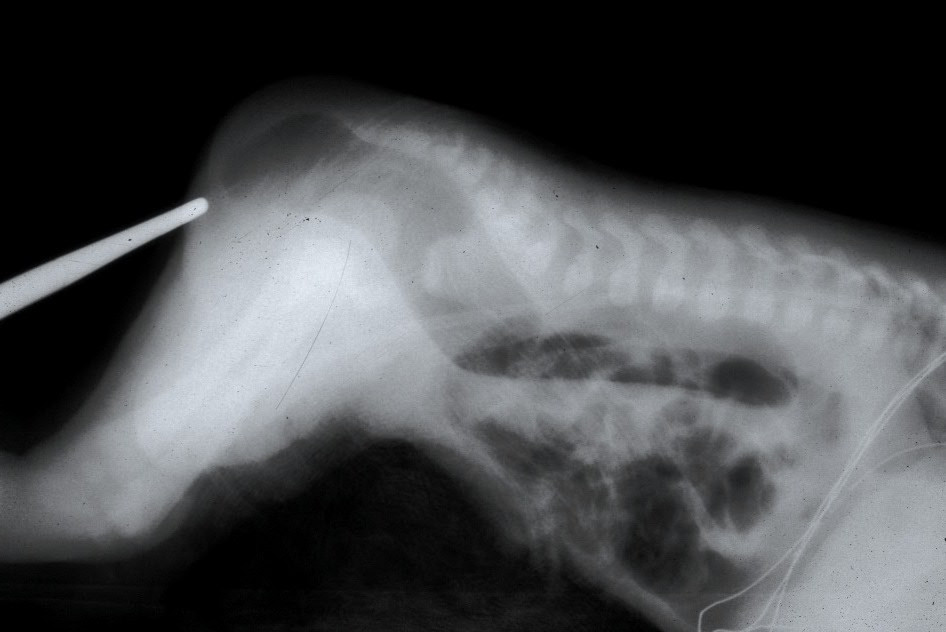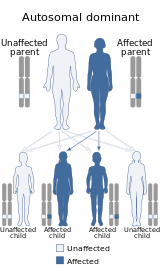Currarino Syndrome

The Currarino syndrome is an inherited congenital disorder where either the sacrum (the fused vertebrae forming the back of the pelvis) is not formed properly, or there is a mass in the presacral space in front of the sacrum, and there are malformations of the anus or rectum. It occurs in approximately 1 in 100,000 people.
Anterior sacral meningocele is the most common presacral mass in patients with Currarino syndrome occurring in 60% of cases. Its presence may significantly affect the surgical management of these patients. Other potential presacral masses include presacral teratoma and enteric cyst. Presacral teratoma usually is considered to be a variant of sacrococcygeal teratoma. However, the presacral teratoma that is characteristic of the Currarino syndrome may be a distinct kind.
Genetics

The disorder is an autosomal dominant genetic trait caused by a mutation in the HLXB9 homeobox gene. In 2000 the first large series of Currarino cases was genetically screened for HLXB9 mutations, and it was shown that the gene is specifically causative for the syndrome, but not for other forms of sacral agenesis. The study was published in the American Journal of Human Genetics.
Diagnosis
Diagnosis of Currarino syndrome is usually clinical, detecting all three elements of the triad. However, genetic testing is often used as the confirmation of diagnosis and genetic analysis of patient's family members.
Treatment
Surgery of an anterior myelomeningocele is not necessarily indicated, only in the rare case in which the space-occupying aspect is expected to cause constipation or problems during pregnancy or delivery. Fistulas between the spinal canal and colon have to be operated on directly.
Importance of early diagnosis and multidisciplinary assessment is recommended to establish adequate treatment if needed.
By accurate evaluation, the correct surgical management, including neurosurgery, can be performed in a 1-stage approach.
The management of Currarino syndrome is similar to the usual management of anorectal malformation (ARM) regarding the surgical approach and probably the prognosis that mainly depends on degree of associated sacral dysplasia.
The cooperation between pediatric surgeons and neurosurgeons is crucial. The follow-up of these patients should be done in a spina bifida clinic.
Neurosurgeons are involved in the surgical treatment of anterior meningoceles, which are often associated with this condition. The accepted surgical treatment is an anterior or posterior or a staged anterior-posterior resection of the presacral mass and obliteration of the anterior meningocele.
The anterior sacral meningocele regresses over time following transdural ligation of its neck.
Posterior approach
A posterior procedure via lumbar and sacral partial laminectomy-laminoplasty and transdural ligation of the neck of the meningocele for anterior sacral meningoceles, or alternatively, tumor excision for other types of presacral lesions.
Endoscopic or endoscope-assisted surgery via a posterior sacral route can be feasible for treatment of some of the patients with anterior sacral meningocele. Anterior meningocele pouch associated with Currarino syndrome will regresses over time following transdural ligation of its neck.
Anterior approach
A 40-year-old woman presenting with cauda equina syndrome and ascending meningitis. The meningocele was removed using an anterior abdominal approach. A sigmoid resection was performed with rectal on-table antegrade lavage followed by closure of the rectal fistula, closure of the rectal stump, and proximal colostomy. Closure of the sacral deficit was carried out by suturing a strip of well-vascularized omentum and fibrin glue
Prompt surgical management using an anterior approach, resection of the sac, closure of the sacral deficit, and fecal diversion resulted in a satisfactory outcome.
See also
- Imperforate anus